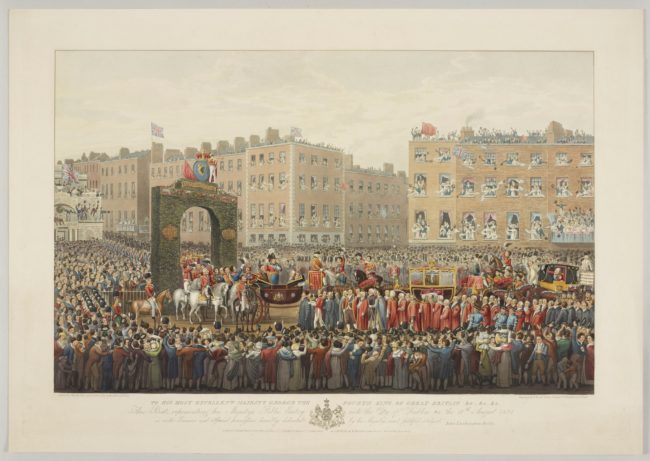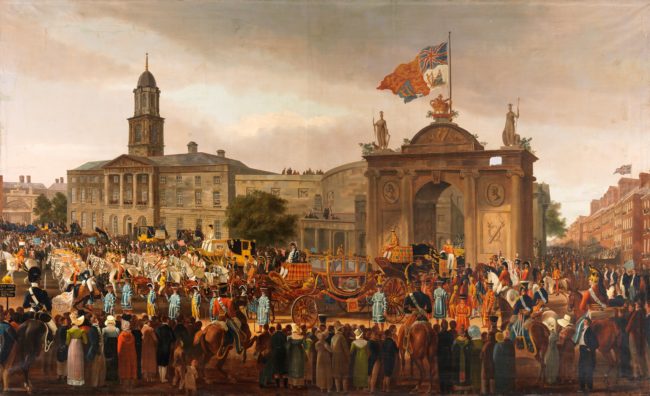Erin’s King: the politics and pageantry of George IV’s visit to Ireland in 1821
By Mary Louise O’Donnell (Independent Scholar), King’s College London Summer Fellow 2020
On 3 September 1821, George IV departed from Dunleary, Dublin, aboard the Royal Yacht. His first and only visit to Ireland began over three weeks earlier when he disembarked at the West Pier in Howth on 12 August. The King was so overwhelmed by the positive reception that he spontaneously announced, ‘this is one of the happiest days of my life. I have long wished to visit you – my heart has always been Irish…this day has shown me that I am beloved by my Irish subjects…and I love Ireland.’ From early in his reign, George IV planned to visit Ireland, and even the death of his estranged wife Caroline five days before arriving in Dublin did not alter his plans. He was determined to reap the benefits of a meticulously orchestrated series of events set in motion in early 1821. The visit was preceded by several meetings in July at which civic leaders and politicians gathered to discuss the itinerary and royal protocol. It was decided that potentially seditious iconography would be prohibited and that the royal visit would be a representation of unity amongst Irish people rather than a forum to reiterate demands for Catholic emancipation and political reform. It was agreed that green flags would not be flown during the Sovereign’s visit, and blue flags with various figures or symbols would be used to honour the King. Prominent Catholics, such as Daniel O’Connell and the Earl of Fingall (Arthur Plunkett), were convinced that by showing loyalty to George IV and acquiescing to the demands by civic and political leaders for unity amongst all creeds and classes, their call for emancipation might, at the very least, be viewed more favourably by their Sovereign.

RCIN 750802: Robert I. Havell, George IV. Entry into Dublin. 17 Aug 1821, 1823 (image courtesy of Royal Collection Trust, (c) Her Majesty the Queen 2021.)
In advance of the visit, several letters were issued through Dublin Castle. These letters outlined the king’s itinerary, detailed the most appropriate manner to welcome him and highlighted his positive kingly attributes. In ‘The King’s Visit to Ireland. In a Letter addressed to the People of Ireland’, the writer noted:
‘A brave and loyal people are always animated, in peace or in war, by the presence of their king: – in war, he leads them to victory or a glorious death, and in peace he establishes their liberty and happiness, and secures their prosperity by the enactment of wise laws…Our king comes with the olive branch, the harbinger of peace: in the spirit of peace let us receive him.’
George IV was presented as a benevolent father figure who loved his subjects and would improve their conditions. He was a true king, and therefore, should be given a hearty, kingly welcome. In the poetry and songs written to celebrate the royal visit in 1821, George IV assumed the role of ‘King of Ireland’ or ‘Erin’s King’.
The earliest reference connecting George to Irish kingship is in an anonymous memorandum dating from 1785. The memorandum’s author proposed that George, Prince of Wales, should be crowned King of Ireland (GEO/MAIN/38099-38105). During the first Regency crisis, the Irish parliament offered George the Regency of Ireland, and, in the mid-1790s, he expressed his desire to become Irish Viceroy. These attempts to engage with Irish politics and the Irish people, and intimations of support for Catholic Emancipation, were well received and suggested that he, unlike his father and grandfather, might be a king who would effect positive improvements in Ireland.
George IV’s visit to Ireland has often been likened to a carefully managed theatrical performance in which the King assumed the principal role. The role of the rest of the cast (from all classes of Irish society) was simple –to show unity, loyalty, not to highlight any grievances, and in return, they would gain benefits – of some kind. His formal entry and procession through the streets of Dublin did not take place until 17 August, but from that day until his departure, military and regal pageantry, elaborately decorated buildings, and a multitude of loyal subjects and curious onlookers greeted the King in Dublin, Kildare and Meath.

NGI.1148: William Turner, George IV, King of England, Entering Dublin, 1821 (image courtesy of the National Gallery of Ireland)
Overall, reactions to the royal visit to Ireland were mixed. The visit was an overwhelming success for George IV. His pubic image was rehabilitated temporarily in Britain, and his confidence was boosted by the apparent loyalty of his Irish subjects. The majority of the King’s Irish subjects, however, earned nothing for their enthusiastic and excessive displays, and it took a further eight years for the Sovereign to allow the emancipation of his Catholic subjects. The reactions were mixed amongst those who played a prominent political role in creating a temporary spirit of loyalty and harmony. Daniel O’Connell’s extreme gestures of loyalty to the Sovereign attracted the wrath of many contemporary writers, including Thomas Moore and Lord Byron (see ‘The Irish Avatar’). They were appalled by O’Connell’s servile behaviour toward a monarch who was generally derided in Britain. However, it was O’Connell who ironically benefitted most from George IV’s visit in 1821. For O’Connell, the pageantry, triumphal processions, flags, and symbols that accompanied the visit provided a crucial model for the mass gatherings agitating for the emancipation of Catholics in the 1820s, and later, repeal of the Act of Union in the 1830s and 40s.
